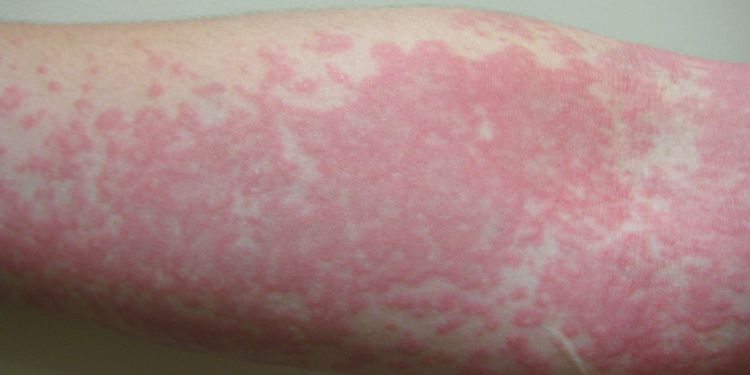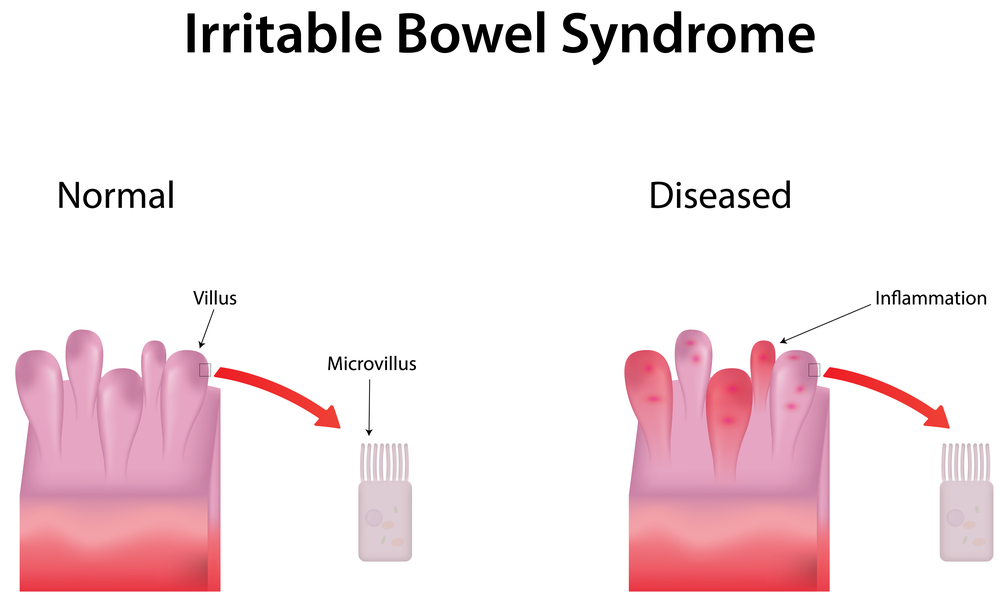Why I Got Hives and How I Got Rid of Them for Good

Only a few short years ago, I lived in ignorant bliss.
I ate whatever I wanted. My diet was a cringe-worthy smorgasbord of pizza, Philly cheesesteaks, chocolate milk, tacos, apple pies, and a ridiculous amount of bread. Oh, and let’s not forget the copious amounts of alcohol I was drinking (I was in college, after all).
It was a fun ride while it lasted, but blissful ignorance can only last so long. Shortly after graduating university, my body decided it had had enough, and a number of mysterious symptoms began to plague me, coming seemingly out of nowhere.
Of the many symptoms I found myself struggling with, one was hives.
Hives is a skin rash characterized by red, swollen, itchy bumps on the skin. Around 10%-20% of the population suffers from hives. While most hives breakouts last only a few days to a few weeks, some suffer from chronic hives, or chronic spontaneous urticaria, where breakouts can occur regularly over periods of months or even years.

Unfortunately, I found myself in this group of chronic hives sufferers. For months, hives was more than a nuisance for me— it was an all-consuming frustration-filled nightmare. I tried every treatment I could get my hands on, but nothing could rid me of hives for more than a week or so.
Thankfully, I did eventually get to the root cause of my hives!
Before I tell you that part of my story, however, let’s take a closer look at hives and where they come from.
How Do You Get Them?
On the surface level, hives are caused by histamine, a chemical that travels in your bloodstream and acts as a neurotransmitter. Histamine is released during inflammatory and allergic responses. It serves to alert your immune system to potential trouble by dilating your blood vessels, allowing white blood cells to more easily access the area and eradicate the source of danger.

Histamine plays a vital role in your bodily health. However, system imbalances do occur, and people can develop what’s known as histamine intolerance. Histamine intolerance can occur due to genetic defects, or it can be triggered by stress, extreme temperature changes, over-exercise, illness, and allergic reactions to food and/or medication.
People with histamine intolerance have trouble producing enough of the enzyme that breaks histamine down. When histamine isn’t broken down properly, this causes problematic histamine buildups. This can lead to wide-ranging symptoms, including migraines, anxiety, chronic fatigue, nausea, and (you guessed it!) hives.
Sometimes, hives show up on their own as a lone symptom and are easily alleviated. Simply address any of the above triggers (e.g., reducing stress, cutting out sensitive foods, or bailing on a new medication) and your hives will disappear.

In other cases (such as mine), hives are much more difficult to get rid of. In chronic hives, the hives are merely surface symptoms of deeper, larger issues in the body. In these cases, hives are often joined by a number of other symptoms, such as brain fog, chronic fatigue, joint pain, food sensitivities, diarrhea/constipation, and more.
If you experience any of these other symptoms along with hives, you may be suffering from something such as the autoimmune disease Hashimoto’s, leaky gut, irritable bowel syndrome, or the presence of the gut parasite Blastocystis hominis. If you already know that you suffer from one of the above disorders, then you’re much more likely to develop hives than normal.
If you suffer from chronic hives, you most likely won’t be able to get rid of them until you find and resolve the deeper issues in your health.

What’s It Like to Have Hives?
Having hives sucks— no use beating around the bush here. Hives is an angry, itchy skin rash that can affect any area of the body.
Having chronic hives significantly impacted my life. I avoided going out whenever possible during outbreaks. When they occurred in visible areas, such as my hands, forearms, or lower legs, I felt insecure about the unsightly rashes on my skin. If I had to go out, like to work or attend a family function, I would wear extra clothing to cover my skin, even if it was uncomfortably hot outside.
Even if none of the breakouts were visible, I’d often choose to stay home alone simply because the rash made it so uncomfortable to be out and about. The itchy hives distracted me from conversation and generally made it difficult to pay attention to people or enjoy much of anything that I was doing.
My relationships suffered because of this. It was simply much easier to stay home and check out by watching movies or playing video games. Anything to distract me from the discomfort and the itching.
Perhaps the worst part of dealing with chronic hives was the fear. I was afraid because I had no idea why these rashes were showing up, and I had no idea what to do to make them go away. I tried traditional treatments for months, but they did nothing but temporarily alleviate symptoms.
Nothing seemed to be working, because nothing was addressing the deeper issues.

How I Got My Hives to Go for Good
In my case, I was dealing with three deeper health issues: candida overgrowth, small intestine bacterial overgrowth (SIBO), and leaky gut.
Years of eating the atrocious diet (abnormally high in gluten, sugar, dairy, and processed foods) I mentioned above had taken its toll. The delicate balance of my intestinal system was ravaged. My gut was full of yeast and bad bacteria, and my intestinal walls were damaged and leaking toxins, microbes, and undigested food particles. My immune system was in overdrive trying (and failing) to deal with the situation.
A number of blood, saliva, and stool tests made things brutally clear for me: to get rid of my hives and get my life back, I had to address the catastrophe that was my gut health.

I did this in four steps:
- I radically overhauled my diet, removing everything that my body had become sensitive to. For many months, I cut dairy, gluten, eggs, sugar, alcohol, and all starches completely out of my diet. To this day, I still steer clear of dairy, gluten, alcohol, and refined sugar.
- I underwent two rounds of the medication Nystatin to kill the yeast and bacterial overgrowth in my gut.
- I started taking a number of supplements to rebuild a healthy gut environment, including probiotics, L-glutamine, magnesium, and zinc.
- I worked with a hypnotherapist to address the strong mind-body connection associated with the histamine system.
After six months or so of this new lifestyle, I was more or less back to normal health and rash-free!

During those six months, I also took advantage of a number of natural options for directly alleviating my hives.
- I took regular warm baths with cornstarch or colloidal oatmeal mixed in the water to soothe and relieve the itching.
- I applied homemade salves of ½ tsp coconut oil mixed with 3 drops of geranium, rose, and lavender essential oils.
- I reduced my intake of high-histamine foods (such as chocolate, berries, citrus fruits, spinach, tomatoes, vinegary/fermented/fried foods, yogurt, seafood, processed/cured/smoked meats, tea, and hot spices like chili powder, cayenne pepper, and curry powder) to reduce the frequency and severity of my hives outbreaks.
- I took supplements that helped reduce not only the severity of the hives themselves, but the number of hives in each outbreak and the number of outbreaks as well.
- Vitamin D3: 4000 IUs daily
- Quercetin, a powerfully anti-inflammatory bioflavonoid found in buckwheat and citrus fruits: 400mg tablets twice a day between meals for 6-8 weeks
- Vitamin C, a powerful antioxidant and antihistamine: 2,000mg daily
- Nettle leaf, which reduces histamine production: 300mg three times daily
- Vitamin B12, which reduces symptom severity: 800mcg daily
There are many resources available on the web detailing further treatment options (both medication-based and all-natural) for hives triggers like histamine intolerance, leaky gut, and the Blastocystis hominis parasite.

Before You Go
Your experience with hives may or may not be at all similar to mine.
Perhaps you have deeper issues at the root of your hives, as I did. If you experience chronic fatigue, headaches, food sensitivities, brain fog, or joint pain at the same time as hives breakouts, consider taking a closer look at what deeper issues may be lurking under the surface. The sooner you can address these issues, the better your life will be!
Or perhaps your hives are simply a surface allergic reaction of some kind. While hives of this nature are more easily addressed, if you experience difficulty breathing, nausea, or lightheadedness at the onset of hives outbreaks, you could be having a strong allergic reaction and might need to go to the hospital.
In any case, while I have you here, I’d like to encourage you to eat a healthy, balanced diet and live a fit lifestyle, simply because the lack of those two things led to so much pain for me.
Take care in what you decide to put in your body, and pay close attention to how your body reacts. Reactions may seem small and insignificant in the moment, but years of inattention can lead to dramatic, painful results, as they did for me.
Take care of your body, and your body will take care of you!
